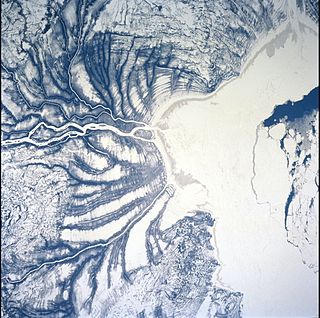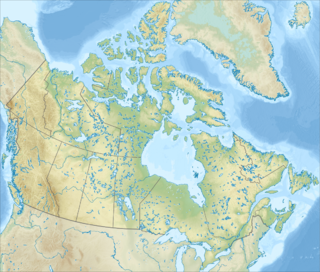| Rasmussen Lowlands | |
|---|---|
| Coordinates | 68°40′N93°0′W / 68.667°N 93.000°W Coordinates: 68°40′N93°0′W / 68.667°N 93.000°W |
| Area | 3,000 square kilometres (1,200 sq mi) |
| Designated | 24 May 1982 |
| Reference no. | 247 [1] |
The Rasmussen Lowlands is a 3,000 km2 coastal plain complex of wetlands in Kitikmeot Region, Nunavut, Canada. It was designated a Ramsar wetland of international importance by the Ramsar Convention on May 24, 1982. [2] It is also classified as an Important Bird Area. [3]
A coastal plain is flat, low-lying land adjacent to a sea coast. One of the largest coastal plains is located in southeastern United States. The Gulf Coastal Plain of North America extends northwards from the Gulf of Mexico along the Lower Mississippi River to the Ohio River, which is a distance of about 981 miles (1,579 km).

Canada is a country in the northern part of North America. Its ten provinces and three territories extend from the Atlantic to the Pacific and northward into the Arctic Ocean, covering 9.98 million square kilometres, making it the world's second-largest country by total area. Canada's southern border with the United States, stretching some 8,891 kilometres (5,525 mi), is the world's longest bi-national land border. Its capital is Ottawa, and its three largest metropolitan areas are Toronto, Montreal, and Vancouver. As a whole, Canada is sparsely populated, the majority of its land area being dominated by forest and tundra. Consequently, its population is highly urbanized, with over 80 percent of its inhabitants concentrated in large and medium-sized cities, with 70% of citizens residing within 100 kilometres (62 mi) of the southern border. Canada's climate varies widely across its vast area, ranging from arctic weather in the north, to hot summers in the southern regions, with four distinct seasons.

The Ramsar Convention on Wetlands of International Importance especially as Waterfowl Habitat is an international treaty for the conservation and sustainable use of wetlands. It is also known as the Convention on Wetlands. It is named after the city of Ramsar in Iran, where the Convention was signed in 1971.
The poorly drained area consists of flat lowlands overlain by marine silts and sand, with numerous tundra ponds throughout. [4]

Drainage is the natural or artificial removal of a surface's water and sub-surface water from an area with excess of water. The internal drainage of most agricultural soils is good enough to prevent severe waterlogging, but many soils need artificial drainage to improve production or to manage water supplies.
Silt is granular material of a size between sand and clay, whose mineral origin is quartz and feldspar. Silt may occur as a soil or as sediment mixed in suspension with water and soil in a body of water such as a river. It may also exist as soil deposited at the bottom of a water body, like mudflows from landslides. Silt has a moderate specific area with a typically non-sticky, plastic feel. Silt usually has a floury feel when dry, and a slippery feel when wet. Silt can be visually observed with a hand lens, exhibiting a sparkly appearance. It also can be felt by the tongue as granular when placed on the front teeth.

Sand is a granular material composed of finely divided rock and mineral particles. It is defined by size, being finer than gravel and coarser than silt. Sand can also refer to a textural class of soil or soil type; i.e., a soil containing more than 85 percent sand-sized particles by mass.
Shorebirds numbering up to 500,000 individuals [4] nest in the ponds and surrounding areas. The vulnerable peregrine falcon nests in the adjacent escarpment, with nearly 6% (80 pairs) of the national population observed here in 1995. [3]

The peregrine falcon, also known as the peregrine, and historically as the duck hawk in North America, is a widespread bird of prey (raptor) in the family Falconidae. A large, crow-sized falcon, it has a blue-grey back, barred white underparts, and a black head. It is believed to be the fastest bird in the world. According to a National Geographic TV programme, the highest measured speed of a peregrine falcon is 389 km/h (242 mph). As is typical of bird-eating raptors, peregrine falcons are sexually dimorphic, with females being considerably larger than males. The peregrine is renowned for its speed, reaching over 320 km/h (200 mph) during its characteristic hunting stoop, making it the fastest member of the animal kingdom.

An escarpment, or scarp, is a steep slope or long cliff that forms as an effect of faulting or erosion and separates two relatively level areas having differing elevations. Usually scarp and scarp face are used interchangeably with escarpment.








